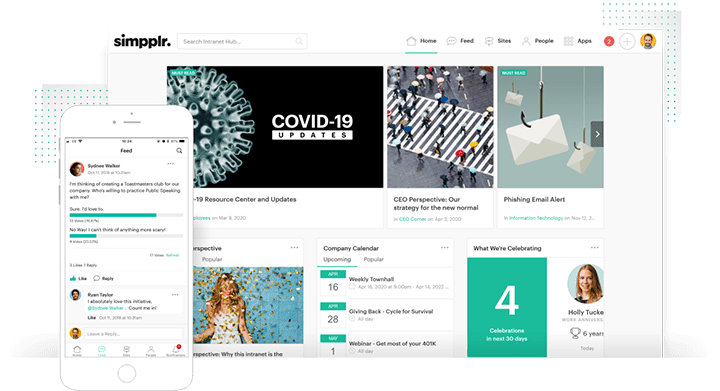Simpplr raises $32M for its intranet platform
Simpplr, a modern platform for building intranet sites (or “employee communications and enablement platforms,” as the company calls it), today announced that it has raised a $32 million Series C round led by Tola Capital. Norwest Ventures, which led the company’s Series B round last year, as well as Salesforce Ventures and George Still Ventures also participated. This brings Simpplr’s total funding to just over $61 million.
As Simpplr CEO and founder Dhiraj Sharma told me, the Series B round was meant to help the team accelerate product innovation and development. Unsurprisingly, the COVID-19 pandemic only increased demand for digital workplace solutions like Simpplr. As Sharma noted, the company’s thesis was always that the world was moving toward remote/hybrid work. The pandemic only accelerated this process and with that, the sense of urgency in its customer base to modernize their own platforms for communicating with their employees. To keep up with this growth, the company doubled its team since last August (though Sharma, just like many other startup founders I’ve recently talked to, also bemoaned that it’s becoming increasingly hard to find talent).
The company says that it added 100 enterprise customers over the course of the last year. Today, its customer base includes a number of early adopters like Splunk or Nutanix, which were always building toward a global workforce and always had a need for a product like Simpplr. But due to the pandemic, more traditional businesses like Fox, AAA insurance or Renewal by Andersen also needed to quickly find ways to support their newly remote workforces.
“When this pandemic happened, there were lots of traditional companies who didn’t think that they would be doing remote work as much in the near future as they had to,” Sharma said. “For them, things changed and then what they realized is that they did not have effective means of formal employee communication and also lacked the digital employee experience — and they realized that very quickly.”
Simpplr is obviously not the only intranet solution on the market, but Sharma argues that the service isn’t just recognized by analyst firms like Gartner and Forrester, but also highly reviewed by its customers, in large part thanks to its focus on user experience. “UX is our number one strength and differentiator. We have been pushing the boundaries of intranet for the last five years,” he said and cited features like the company’s auto-governance engine, which he likened to a “Roomba for your intranet.”
Analytics, too, is another area where Simpplr is trying to differentiate itself. “Our company’s mission is to help companies build a better workplace — and unless we can show the areas of improvement and provide insights like how to do something better, we just become a dumb tool,” he said. “For us, what is very important is not only that you are communicating but helping our customers to understand what’s working and what’s not working. What’s the impact of the communication and how are your employees feeling about it?”
Looking ahead, the company is working on building more AI into its tools — including its analytics — to help companies better communicate with their employees and understand the impact of those messages.
As for the new funding round, Sharma noted that he bootstrapped his previous two companies, which has made him take a somewhat conservative approach to fundraising. “When I used to hear that your investors or VCs expect growth at all costs, I just could never understand that,” he said. “So while building this company, even though this is a venture-funded company, I still wanted to make sure that I use the finances responsibly and I build a business in a sustainable manner. I wanted to make sure that if we raised a large investment, we have a proper use for that investment and that this investment will bring the right results.”
Tola Capital principal Eddie Kang will now join Simpplr’s board. “The future of work is hybrid and Simpplr is essential to a company’s ability to engage with employees,” he said. “As enterprise software investors, what excites us about Simpplr’s platform is that it allows leadership teams to streamline communications across channels and provides a turnkey platform that drives value to customers very quickly. Our partnership with Simpplr will accelerate its roadmap to meet the needs of global business leaders and communications teams.”
![]()













